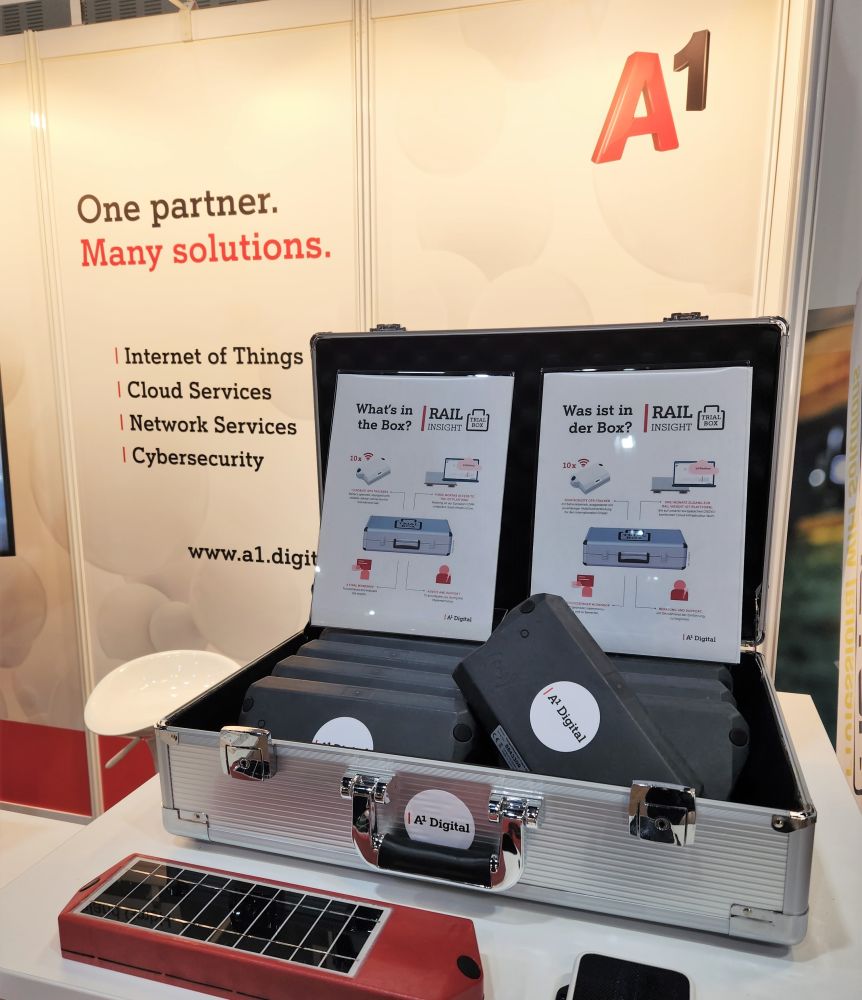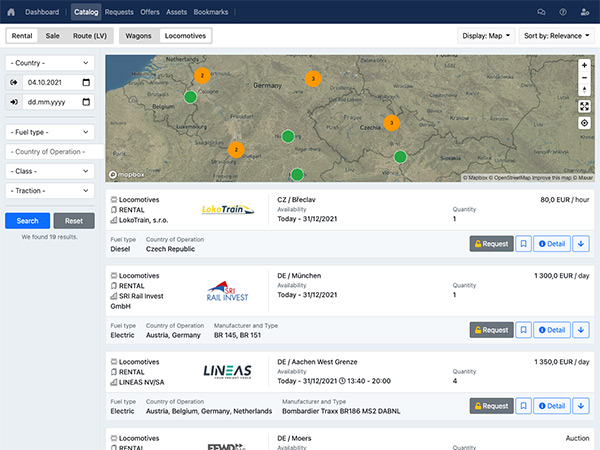The most important customer, Rail Cargo Austria, has A1 Digital’s devices installed on over 11,000 wagons (more than 2.000 for Rail Cargo Hungaria). Over time, A1 Digital has gathered vast data from the devices. What were they useful for? What are the key learnings and potentials? And can you rent a few devices to try it out on your fleet? We asked the questions, and A1 experts Jürgen Rudolf, Senior Expert and Consultant for Rail Insight Solutions at A1 Digital, Stefan Höltinger, Senior Data Scientist and Machine Learning Consultant, and Philipp König, Product Marketing Manager IoT at A1 Digital, answered.
How would you summarize the evolution of railways from analogue to digital in the area of tracking and tracing freight wagons in a nutshell?
Jürgen Rudolf: Rail businesses are not the most progressive on this planet, and some have been doing things the same way for nearly 200 years. Everything was totally analogue. In recent years, new initiatives have equipped and connected the assets to the Internet network.
The first step was to know where your freight cars were. This helped us to get better estimates for arrivals to clients or to know where my wagons are compared to the area where they are requested for logistic reasons.
Step two was coming from the maintenance point of view –knowing what the exact mileage of the freight car is. Especially in the single wagonload traffic, the freight cars were absolutely out of the scope of the wagon owner, who often had no idea where they were. So tracking and tracing enables customers to know where their cargo is precisely. Owners know their mileage, which also allows better planning for maintenance intervals. With more data, we can even predict the estimated time of the wagon's arrival to destinations. Installing additional sensors allows condition-based maintenance and so on. And with the help of artificial intelligence, we are talking about predictive maintenance.

For many people in railway companies, the Internet of Things (IoT) and AI are completely strange words. How would you describe its potential use for people in the analogue world of railways?
Jürgen Rudolf: You are touching the right point. We do not want to talk with our customers about technical possibilities, specifications, etc. We want to talk about recommendations for business cases, the advantages it bring, why to do it and about quick return on investment. We transfer analogue assets to data driven business models. Because that’s what is attractive to them – optimizing the logistics and maintenance issues. The IoT is the tool behind it. A device that will enable railways to contribute to minimizing climate change and decreasing CO2 emissions.
A1 Digital introduced the hardware and software for tracking and tracing, but since then, the product evolved. What can your solution bring to the customers now?
Jürgen Rudolf: We are one of few companies that are a one-stop shop for digitalizing freight wagons. We are not simply selling hardware, software, connectivity, or anything else. We select the right choice from each of these partial segments suitable for a specific customer, i.e. we offer solutions. We have the IoT platform, where the transmitted data from freight wagons are received and processed, and it can also send information, such as remote updates, configuration adjustments, calibration, etc., back to the wagon. Not many railway companies have sophisticated asset management platforms where we can input these data. Instead, they work on Excel sheets and similar ways of operation, and we have to find a way to integrate our data there or propose more modern platforms for data processing. And we provide this throughout the whole chain up to data analysis and machine learning. This helps to maximize the potential hidden inside of these data for the company's advantage. The demand from the customers changes from customer to customer, but we mainly talk about predictive maintenance, wagon conditions, or vibration data.

Stefan Höltinger: Doing things the “old way” with only Excel is not unique to the railways but still common in many segments. We also offer our machine learning platform, which is easy to use via the dashboard and allows a smooth transition from Excel to more advanced machine learning analytics. You can load data from an Excel sheet and test various machine-learning algorithms to achieve the best solution. You can still export the result back to Excel, but the ultimate goal is to digitalize the entire process.
Among the features your solution provides is vibration data, or shock sensors. How is this useful for the wagon owner or rail freight carrier?
Stefan Höltinger: Vibration data is the key to many use cases beyond tracking and tracing. It provides valuable information on how the wagon is handled, e.g., during shunting or loading and unloading. This information can be very useful for more targeted wagon inspections and optimizing maintenance cycles. Depending on the type of wagon you use and the goods you transport, you can set specific thresholds for wagon vibration– or an acceptance level of vibration. If the vibration exceeds the threshold, you can assume the car to be damaged and arrange an inspection. This is only possible after gathering data from many wagons and applying machine learning models to each type of freight car.
How does machine learning work in the case of rail freight wagons?
Stefan Höltinger: As a first step, you must ensure that the sensors you are using, provide useful vibration data for your application (i.e., appropriate frequency and features). In the second step, you gather data from your units for several months. Then you can use this data to find interesting patterns -and that is where machine learning helps the most. Together with domain experts you then validate the identified shock patterns and assign them to certain events. This way you can develop even better predictions and information for the future.
Can you give us a specific example?
Stefan Höltinger: Sure. For example, you know that a specific customer uses a particular type of wagon, and there is a usual scale of vibrations when the wagons are loaded and unloaded at different customer’s sidings. If you then observe unseen shock patterns, the algorithm identifies those anomalies in vibrations, which could indicate improper handling with cargo loading and unloading. Then you can assume the wagon will need a thorough check for damage.
How did the inquiry for shock sensors come to your solution?
Jürgen Rudolf: The initial task from Rail Cargo was to have a shock sensor on board to know where improper loading happens. They had much damage, especially with customers loading iron scrap, trying to tamper the loaded scrap to load some more. The costs caused by this improper handling were reaching millions per year. And they wanted to know where it happened. The 3D shock sensor that records this is a standard part of our device. It is also used during hard shunting when wagon buffers make contact at speeds above the allowed range. Improper cargo loading or shunting is an indication that wagons must go to the workshop for inspection.
Another case was with wagons on the move – we recorded shocks that did not impact the freight wagon but regularly appeared in the exact location. This can be an indication of track damage. Out of these geolocations, we were able to create heat maps with spots that need the attention of the infrastructure manager – public or private, when it happens on a siding, for example.
We can also indicate a flat spot on the wagon wheel with tiny but regular vibrations. So this all surprised us – how a shock sensor can be helpful for operators, wagon owners, maintenance of the rolling stock and rail track, and the prevention of accidents.
Stefan Höltinger: A positive effect for new customers is that we have already gathered and analyzed a lot of data and potential solutions. Thus, new customers benefit from this experience and past improvements to the solution.
The potential benefit of infrastructure maintenance is what caught my attention. Do you see these data from heat maps being shared with infra companies, and are things getting fixed?
Jürgen Rudolf: The potential is there, but it is mostly not being utilized at the moment. Although the operator and infrastructure company belong to the same group, those who pay for solutions treat the data as their own. There are uncertainties about rights and duties of data sharing, so most data owners are unwilling to share it for a common benefit. I understand it on the one hand. On the other hand, sharing can lead to a bigger goal: making railways more competitive and future-oriented, which we all want. It would be a true win-win.
Let’s come back to the solutions you provide. So it’s all in one – hardware, software and data processing, correct?

Jürgen Rudolf: Yes, we select the optimized hardware, connect it to the IoT platform, analyze data and provide user platforms. Way beyond that, I’ll give you an interesting example: Rail Cargo had an estimated time limit of 30-40 minutes for a device to be activated, mounted on a wagon, and the wagon number to be connected with the device number in all systems and tested if it worked properly. We cooperated closely with eleven Rail Cargo workshops to optimize this procedure, and we could shorten this time limit to six minutes. We also created a suitcase with all the necessary tools for doing it. Nearly half an hour saved time multiplied by 11,000 wagons is a considerable time-saving (and cost-saving of several person-years!).
Rail Cargo has its in-house workshops you could collaborate with. How about customers who need to contract workshops for their fleets and want to have these devices mounted?
Jürgen Rudolf: We always combine mounting with service intervals of the wagons instead of chasing wagons to install it anywhere and anytime. We can do workshop mounting practically anywhere, and no special equipment is needed – as we said, all we need to deliver is one suitcase.
The planned digital automated coupling (DAC) will have a power line and data gathering. Will this mean the device you provide on freight cars will be redundant?
Jürgen Rudolf: Not at all. DAC is a really great European initiative. The data bus will send the data to the locomotive. But who will send the data from a specific railcar to the wagon owner? The forwarder might change, and traction companies too – and ensuring you always get the same data from all of them is impossible. Plus, if used in single wagonload traffic, wagons get uncoupled and reconnected again, and the complexities rise exponentially. Thus, fleet owners will still need this digital solution for many years – easy to mount without any wired connection.

Let’s say I am a customer and would like to try this solution, but I am not fully committed to implementing it in my entire wagon fleet. Is there a way to go for a trial?
Jürgen Rudolf: Yes, we call it Rail Insight Trial Box. We will send a box with ten devices that are easy to mount on a freight wagon through a magnetic backside. The customer will write which device is on which wagon and then will get access to dashboards showing data from these ten wagons for three months. This includes tracking and tracing and other needs from the customer. After the quarter of the year, the customer sends us the devices back, and our data analysts will process the gathered information. In the end, we will have a post-workshop with the customer about our findings and show what we can do with this data.
If potential customers are interested in speaking to you and discussing using your solution further, what is the best way to start?
Philipp König: A good way is to visit the Rail Insight page on our website and request a free, non-binding consultation with one of our experts through the form. For those who prefer watching videos, I recommend checking out the recording of our recent webinar featuring our customer, Rhaetian Railway.

